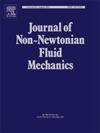Potential applications of elastic instability and elastic turbulence: A comprehensive review, limitations, and future directions
IF 2.8
2区 工程技术
Q2 MECHANICS
引用次数: 0
Abstract
Viscoelastic fluids, a subclass of complex fluids, are employed across various applications, from biological processes to large-scale industrial operations. These fluids exhibit complex flow behaviors resulting from non-linear elastic stresses that arise from the stretching and relaxation of their microstructures, such as polymer molecules in viscoelastic polymer solutions, within a deformed flow field. One notable phenomenon associated with these fluids is purely “elastic instability” (EI), which occurs when elastic stresses interact with the streamline curvature in a flow system at low Reynolds numbers (the ratio of inertial to viscous forces). Specifically, EI manifests when the Weissenberg number (the ratio of the microstructure relaxation time to the rate of flow deformation) surpasses a critical threshold. As the Weissenberg number continues to increase, the unstable flow field resulting from EI further transits to a more chaotic and turbulent-like flow state known as “elastic turbulence” (ET). The fluctuating hydrodynamics characteristics of ET display statistical similarities to conventional Newtonian turbulence observed at high Reynolds numbers. Over the past two decades or so, extensive research has been conducted within the complex fluids research community to explore these two phenomena, resulting in several comprehensive articles that outline the development and understanding of ET. This article focuses on the potential application perspectives of these two phenomena. In particular, this article aims to provide a thorough review of the applications of EI and ET phenomena, particularly in three main areas: microfluidic mixing, microscale heat transfer, and chemically enhanced oil recovery (EOR) processes. Furthermore, this review will also provide a discussion on the limitations and future research directions associated with these two phenomena, highlighting their potential from an application standpoint.
弹性不稳定性和弹性湍流的潜在应用:综合综述、局限性和未来方向
粘弹性流体是复杂流体的一个子类,从生物过程到大规模工业操作,粘弹性流体被广泛应用。这些流体表现出复杂的流动行为,这是由于其微观结构(如粘弹性聚合物溶液中的聚合物分子)在变形流场中的拉伸和松弛而产生的非线性弹性应力造成的。与这些流体相关的一个值得注意的现象是纯粹的“弹性不稳定性”(EI),当弹性应力与低雷诺数(惯性与粘性力之比)流动系统中的流线曲率相互作用时,就会发生这种情况。具体来说,EI表现为Weissenberg数(微观结构松弛时间与流动变形速率之比)超过临界阈值。随着Weissenberg数的不断增加,EI产生的不稳定流场进一步过渡到更加混乱和类似湍流的流态,称为“弹性湍流”(elastic turbulence, ET)。ET的波动流体力学特性显示出在高雷诺数下观测到的传统牛顿湍流的统计相似性。在过去二十年左右的时间里,在复杂流体研究界进行了广泛的研究来探索这两种现象,产生了几篇概述ET发展和理解的综合文章。本文重点关注这两种现象的潜在应用前景。本文旨在全面回顾EI和ET现象的应用,特别是在三个主要领域:微流体混合,微尺度传热和化学提高采收率(EOR)过程。此外,本文还讨论了这两种现象的局限性和未来的研究方向,并从应用的角度强调了它们的潜力。
本文章由计算机程序翻译,如有差异,请以英文原文为准。
求助全文
约1分钟内获得全文
求助全文
来源期刊
CiteScore
5.00
自引率
19.40%
发文量
109
审稿时长
61 days
期刊介绍:
The Journal of Non-Newtonian Fluid Mechanics publishes research on flowing soft matter systems. Submissions in all areas of flowing complex fluids are welcomed, including polymer melts and solutions, suspensions, colloids, surfactant solutions, biological fluids, gels, liquid crystals and granular materials. Flow problems relevant to microfluidics, lab-on-a-chip, nanofluidics, biological flows, geophysical flows, industrial processes and other applications are of interest.
Subjects considered suitable for the journal include the following (not necessarily in order of importance):
Theoretical, computational and experimental studies of naturally or technologically relevant flow problems where the non-Newtonian nature of the fluid is important in determining the character of the flow. We seek in particular studies that lend mechanistic insight into flow behavior in complex fluids or highlight flow phenomena unique to complex fluids. Examples include
Instabilities, unsteady and turbulent or chaotic flow characteristics in non-Newtonian fluids,
Multiphase flows involving complex fluids,
Problems involving transport phenomena such as heat and mass transfer and mixing, to the extent that the non-Newtonian flow behavior is central to the transport phenomena,
Novel flow situations that suggest the need for further theoretical study,
Practical situations of flow that are in need of systematic theoretical and experimental research. Such issues and developments commonly arise, for example, in the polymer processing, petroleum, pharmaceutical, biomedical and consumer product industries.

 求助内容:
求助内容: 应助结果提醒方式:
应助结果提醒方式:


